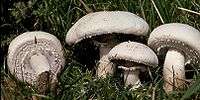Agaricus arvensis
| Horse mushroom | |
|---|---|
| | |
| Agaricus arvensis | |
| Scientific classification | |
| Kingdom: | Fungi |
| Division: | Basidiomycota |
| Class: | Agaricomycetes |
| Order: | Agaricales |
| Family: | Agaricaceae |
| Genus: | Agaricus |
| Species: | A. arvensis |
| Binomial name | |
| Agaricus arvensis Schaeff. | |
| Agaricus arvensis | |
|---|---|
|
| |
| gills on hymenium | |
| cap is convex | |
| hymenium is free | |
| stipe has a ring | |
|
spore print is brown to blackish-brown | |
| ecology is saprotrophic | |
| edibility: choice | |
Agaricus arvensis, commonly known as the horse mushroom, is a mushroom of the genus Agaricus.
Taxonomy
It was described as Agaricus arvensis by Jacob Christian Schaeffer in 1762, and given numerous binomial descriptions since. Its generic name arvensis means 'of the field'.
Description

The cap is similar to that of Agaricus campestris (the field mushroom). The gills are white at first (when this fungus is most often confused with deadly Amanita genus). They later pass through grey and brown to become dull chocolate. There is a large spreading ring, white above but sometimes with yellowish scales underneath. Viewed from below, on a closed-cap specimen, the twin-layered ring has a well-developed 'cogwheel' pattern around the stipe. This is the lower part of the double ring. The odor is described as like anise.[1] It belongs to a group of Agaricus which tend to stain yellow on bruising.
Similar species
- Agaricus osecanus is rare, and is without the aniseed smell.[2]
- Agaricus xanthodermus, the yellow stainer, can cause stomach upsets.
- Agaricus silvicola, the wood mushroom, is a touch more arboreal, with a frail and delicate ring, but also edible.
- Agaricus campestris, the field mushroom, is generally (but not always) smaller, has pink gills when young, and is also edible.
- Agaricus bitorquis, the spring agaric(us); looks similar to arvensis and campestris, which are more common in the summer and autumn
- Agaricus bisporus is the more commonly cultivated mushroom of the Agaricus genus.
Distribution and habitat
It is one of the largest white Agaricus species in Britain (where it appears during the months of July-November), West Asia (Iran)[3] and North America. Frequently found near stables, as well as in meadows, it may form fairy rings. The mushroom is often found growing with nettles (a plant that also likes nutrient-rich soil). It is sometimes found associated with spruce.[4]
Conservation
This mushroom is considered common and widespread, and is not a conservation concern.[5]
Edibility
Much prized by farmers for generations, the horse mushroom is regarded as one of the most delicious edible fungi, although the fruitbodies of this and other yellow-staining Agaricus species often have a build-up of heavy metals, such as cadmium and copper.[5]
See also
References
- ↑ Miller, Orson. Mushrooms of North America. New York: E.P. Dutton, 1984.
- ↑ Roger Phillips (2006). Mushrooms. Pan MacMillan. ISBN 0-330-44237-6.
- ↑ Asef Shayan MR. (2010). قارچهای سمی ایران (Qarch-ha-ye Sammi-ye Iran) [Poisonous mushrooms of Iran] (in Persian). Iran shenasi. p. 214. ISBN 978-964-2725-29-8.
- ↑ Lincoff, Gary. The Audubon Society Field Guide to North American Mushrooms. Chanticleer Press: New York, 1981.
- 1 2 "Plants & Fungi: Agaricus arvensis (horse mushroom) - Species profile from". Kew. Retrieved 2013-05-19.
| Wikimedia Commons has media related to Agaricus arvensis. |
External links
- Mushroom-collecting.com - Agaricus arvensis
- Mushroom Expert - Agaricus arvensis
- Mykoweb - Agaricus avernsis